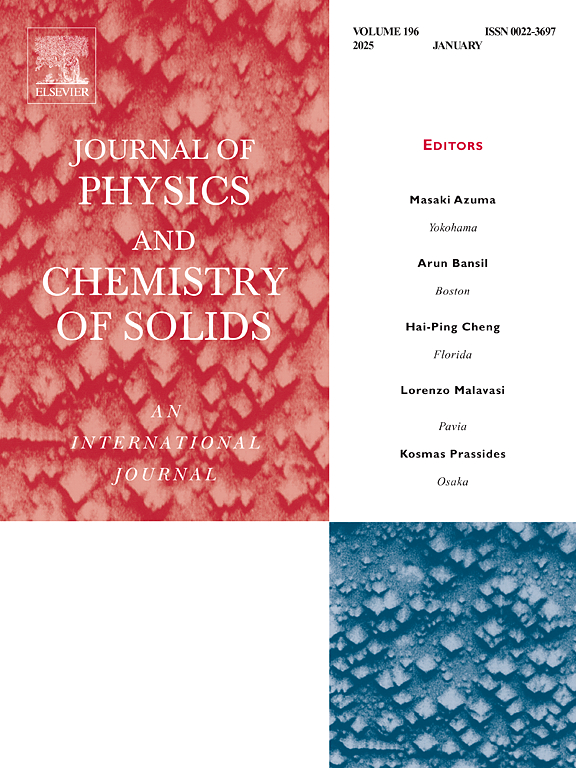“Enhanced supercapacitor and catalytic properties of CuMn-MOF/Ag composites for energy storage and hydrogen evolution”
IF 4.3
3区 材料科学
Q2 CHEMISTRY, MULTIDISCIPLINARY
引用次数: 0
Abstract
Supercapattery devices combine supercapacitors' high power density (Pd) and cycling longevity with batteries' energy density (Ed). Metal-organic frameworks (MOFs) are ideal for energy storage due to their enhanced surface area, tunable porous architecture, and structural durability. In this study, CuMn-MOF doped with Ag nanoparticles was synthesized via the hydrothermal method, which offers precise control over morphology and crystallinity. The resulting CuMn-MOF/Ag composite, characterized by XRD, SEM, XPS, and BET analysis, demonstrated well-defined crystalline structures with a high surface area. Electrochemical evaluations revealed a phenomenal capacity density (Qs) of 2800 C/g at 2.0 A/g in three-electrode systems. When employed in a supercapattery device (CuMn-MOF/Ag//AC), the composite executed a specific energy of 63 Wh/kg at a specific power of 1690 W/kg, with remarkable cycling performance, retaining 90 % of its capacity over 12,000 cycles. CuMn-MOF/Ag exhibited efficient hydrogen evolution reaction (HER) performance, with a minimal overpotential of 101.41 mV and a Tafel slope of 50.0 mV/dec. The combination of high-performance energy storage capabilities and efficient catalytic activity underscores the versatility of CuMn-MOF/Ag for applications in renewable energy systems, hydrogen production, and portable electronics.
超级电池装置结合了超级电容器的高功率密度(Pd)和循环寿命以及电池的能量密度(Ed)。金属有机框架(MOF)具有更高的比表面积、可调的多孔结构和结构耐久性,是理想的储能材料。本研究通过水热法合成了掺杂有银纳米颗粒的 CuMn-MOF,该方法可精确控制形态和结晶度。通过 XRD、SEM、XPS 和 BET 分析,得到的 CuMn-MOF/Ag 复合材料显示出具有高比表面积的清晰结晶结构。电化学评估显示,在三电极系统中,当电流为 2.0 A/g 时,电容量密度 (Qs) 达到惊人的 2800 C/g。在超级电池装置(CuMn-MOF/Ag//AC)中使用时,复合材料在比功率为 1690 W/kg 时的比能量为 63 Wh/kg,循环性能卓越,在 12,000 次循环后仍能保持 90% 的容量。CuMn-MOF/Ag 具有高效的氢进化反应(HER)性能,过电位最低为 101.41 mV,塔菲尔斜率为 50.0 mV/dec。高性能的储能能力和高效的催化活性相结合,凸显了 CuMn-MOF/Ag 在可再生能源系统、制氢和便携式电子产品中的多功能应用。
本文章由计算机程序翻译,如有差异,请以英文原文为准。
求助全文
约1分钟内获得全文
求助全文
来源期刊
CiteScore
7.80
自引率
2.50%
发文量
605
审稿时长
40 days
期刊介绍:
The Journal of Physics and Chemistry of Solids is a well-established international medium for publication of archival research in condensed matter and materials sciences. Areas of interest broadly include experimental and theoretical research on electronic, magnetic, spectroscopic and structural properties as well as the statistical mechanics and thermodynamics of materials. The focus is on gaining physical and chemical insight into the properties and potential applications of condensed matter systems.
Within the broad scope of the journal, beyond regular contributions, the editors have identified submissions in the following areas of physics and chemistry of solids to be of special current interest to the journal:
Low-dimensional systems
Exotic states of quantum electron matter including topological phases
Energy conversion and storage
Interfaces, nanoparticles and catalysts.

 求助内容:
求助内容: 应助结果提醒方式:
应助结果提醒方式:


